Wildlife
Our range of tours offer you the opportunity to see a range of wildlife including whales, porpoise, dolphins, basking sharks, otter, golden and white tailed sea eagles and much more in our European Special Area of Conservation – Firth of Lorn. However, with wildlife there can be no guarantees, please call us on 01852 300 003 or email us at oban@seafari.co.uk to ask us what we’ve been seeing recently – we will always give you an honest answer !
Our routes throughout the Firth of Lorn pass through some incredibly biodiverse ecosystems, on land and at sea, supporting a great range of animals from the smallest of fish to the largest land mammal and bird of prey the UK has to offer. Our year round residents are spectacular enough but we also have some incredible seasonal visitors too. This page showcases some of the wildlife we regularly get to see on our trips.
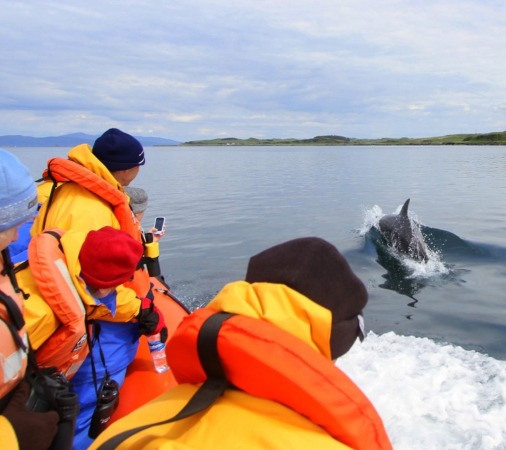
Year Round Wildlife – Residents
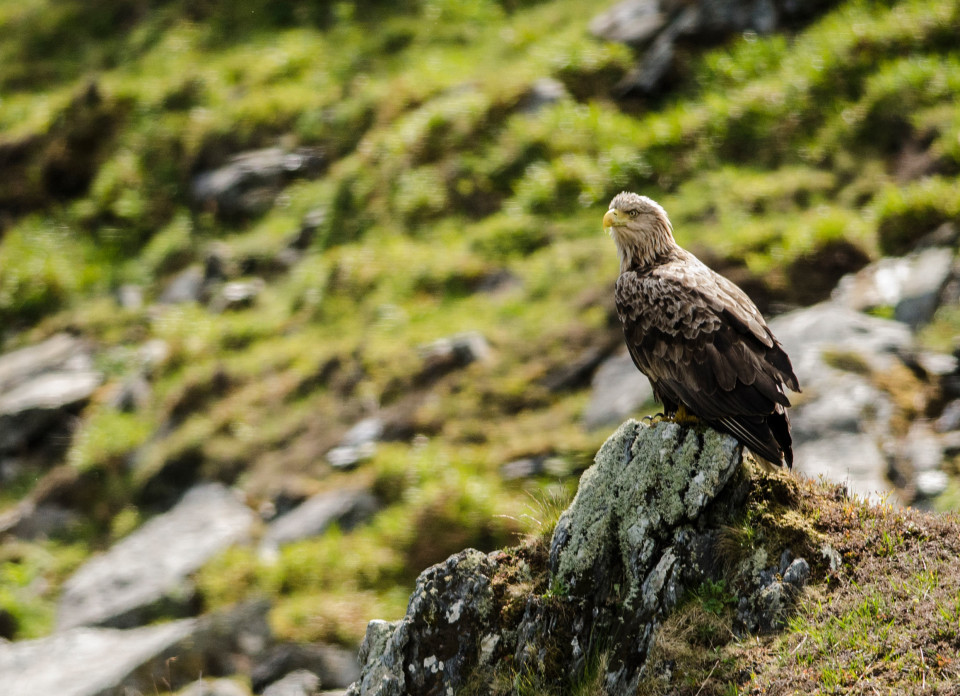
The White Tailed Sea Eagle
This is the UK’s largest raptor and are often thought of as the fourth largest eagles in the world, their wingspan can be up to 2.5m, they are so large they are commonly referred to as ‘flying barn doors’. Less aerially agile than the golden eagle they soar on flat wings but they are still formidable predators, taking mammals, birds and fish as prey, they are opportunistic feeders and will even feed on carrion. They develop their white tail when they reach adulthood at around 5 years of age and can live up to 25 years.
It is a joy to see them back in the UK after human persecution lead to their local extinction in the UK in the early 1900s. A reintroduction effort started on the Isle of Rum in 1975 and now 40 years on they seem to be flourishing and spreading down the islands and on to the mainland. The gaelic name for the white tailed sea eagle is “iolaire sùil na gr?ine” meaning ‘eagle of the sunlit eye’, for its beautiful golden eye.
The Golden Eagle
The second largest raptor in the UK with a wing span of around 2m, although not the largest of our raptors they do have an air of majesty and have long been symbolic of power and strength throughout their range. These large birds are expert hunters and feed on small mammals, birds and sometimes carrion. Their keen eyesight helping them hone in on prey from great distance, they have awe inspiring agility in flight and during courtship displays perform undulating flight, flying upwards then swooping at great speed.
They will have up to 5 eyries in their extremely large territories which can be up to 150Km², nesting on craggy cliffs and in tall trees, they will add nesting material each year they reuse a nest, which can make nesting structures incredibly large! Tending to lay 2-3 eggs per clutch it is usually only one chick that fledges, although in some rare cases twins and even triplets have been reared to fledging.
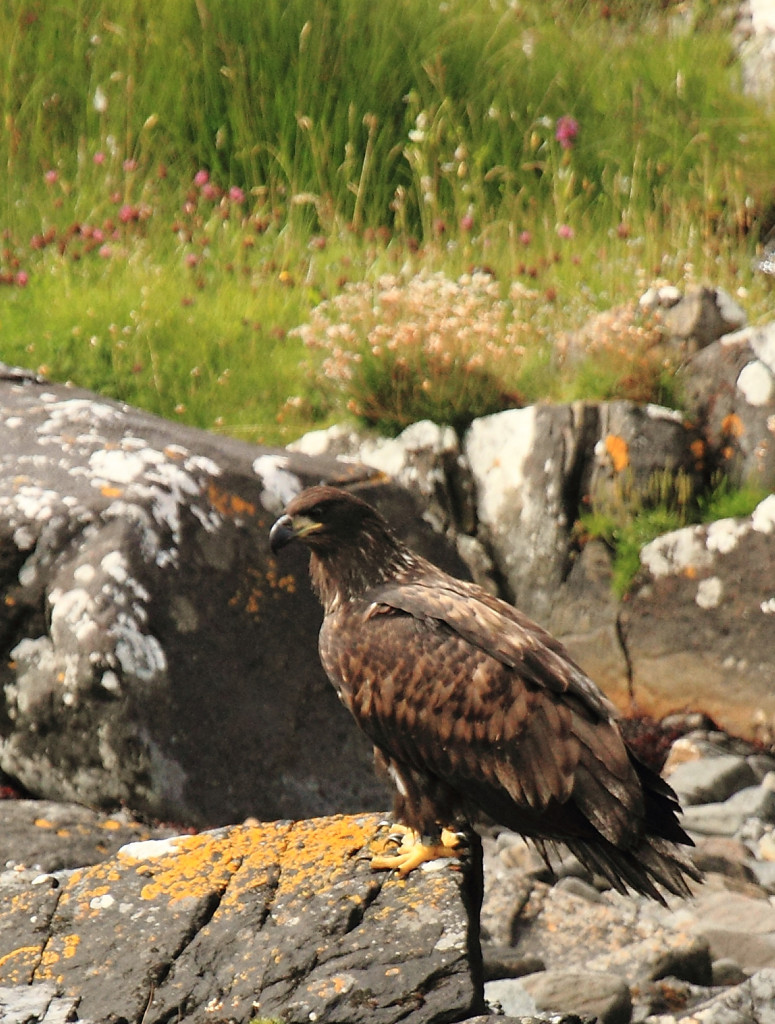
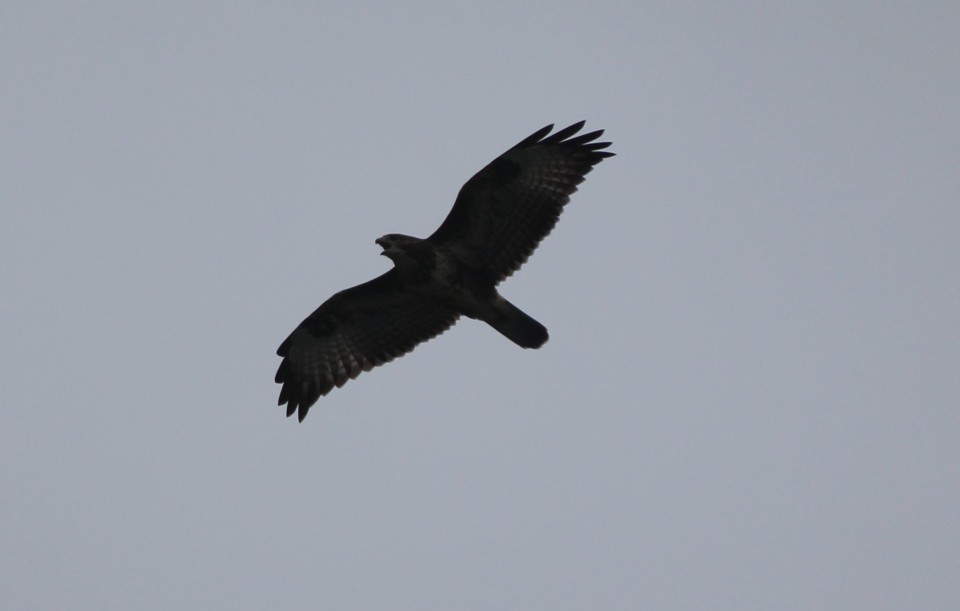
The Buzzard
The Buzzard is the most numerous bird of prey in the UK, it is a medium sized raptor with a large range of colour morphs, from very pale to almost black, they have a paler patch on the underside of the wings that can help identify them during flight.
The Common Seal
The common seal is smaller than the grey seal, the larger males being up to 1.9m, they have a very dog like profile with their large eyes and pronounced muzzle. Named common as they have a wide geographic range they are less numerous than the grey seal in the UK. They pup in early summer and the pups are able to swim hours after birth, but they do have a little encouragement from mum and if they get a little tired mum’s there for a piggyback! As adults they are able to dive for up to 30 minutes and have been found to go to a depth of 500m, however their normal dive profile tends to be less than 4 minutes at a depth of less than 20m to get their favourite prey of small fish like sand eels.
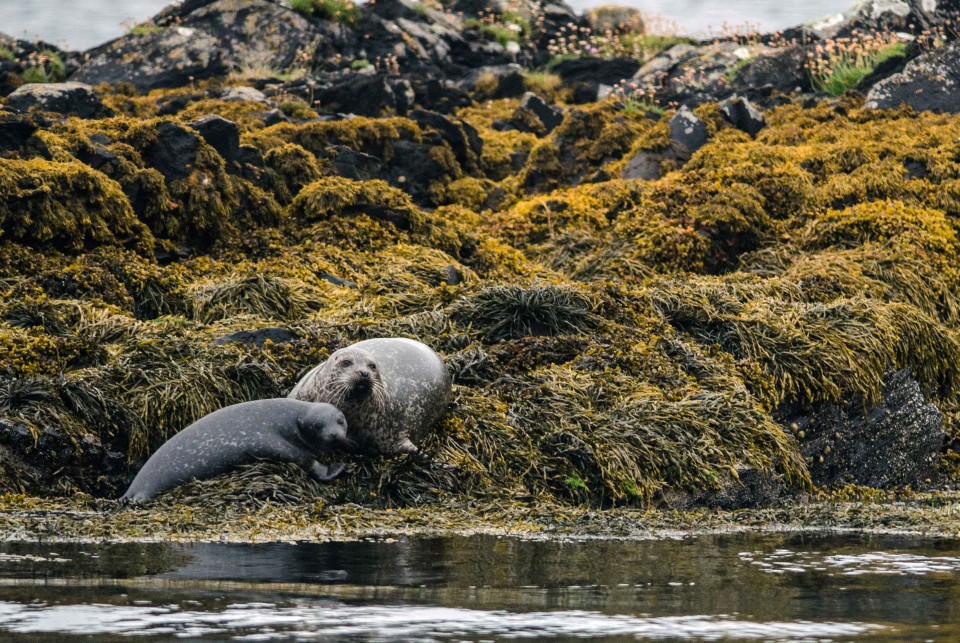
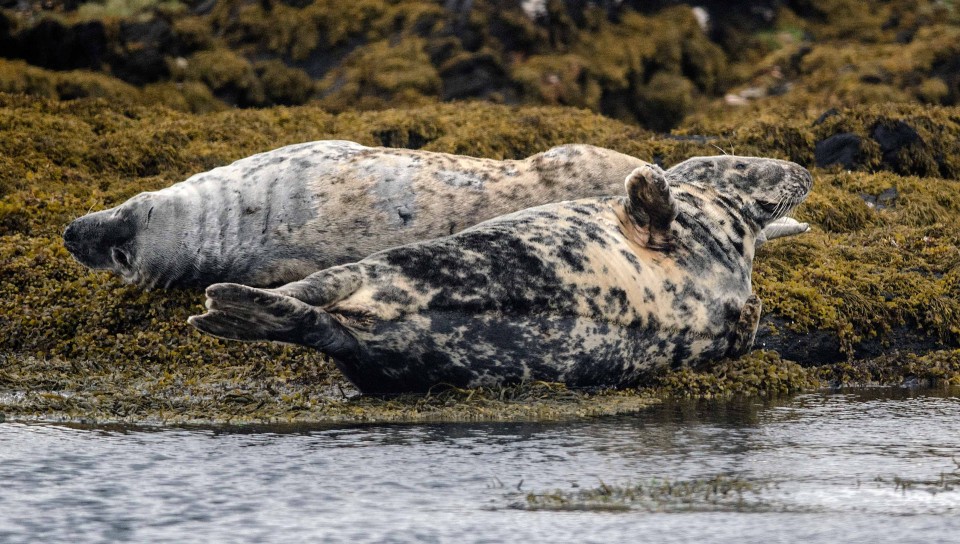
The Grey Seal
The grey seal is the larger of the two species of seal that breed in the UK, the bulls (males) can reach over 2m in length with the females being slightly smaller at around 1.8m. They are superbly adapted to life at sea, being able to hold their breath for over 1 hour and like all true seals don’t have external ear structures and have small forelimbs. They can only shuffle about on land but have fantastic agility underwater. They spend most of their lives at sea but we often see them hauled out resting and regulating their temperature, because although their blubber helps them stay warm underwater sometimes they need to warm up on land.
The Harbour Porpoise
The harbour porpoise is the smallest cetacean we see in British waters, they are a coastal species never ranging further than 10km from land. Growing up to 1.9m, they have a small triangular dorsal fin in the middle of their back. Locally they are also known as the puffing pig as when they surface to breath they make a sneezing like sound. Like all the toothed cetaceans they use echolocation to hunt their prey and will often feed collaboratively, numerous individuals rounding up a shoal of fish into a tight ball and forcing them close to the surface, the porpoise then take it in turn to pick fish off from the shoal.
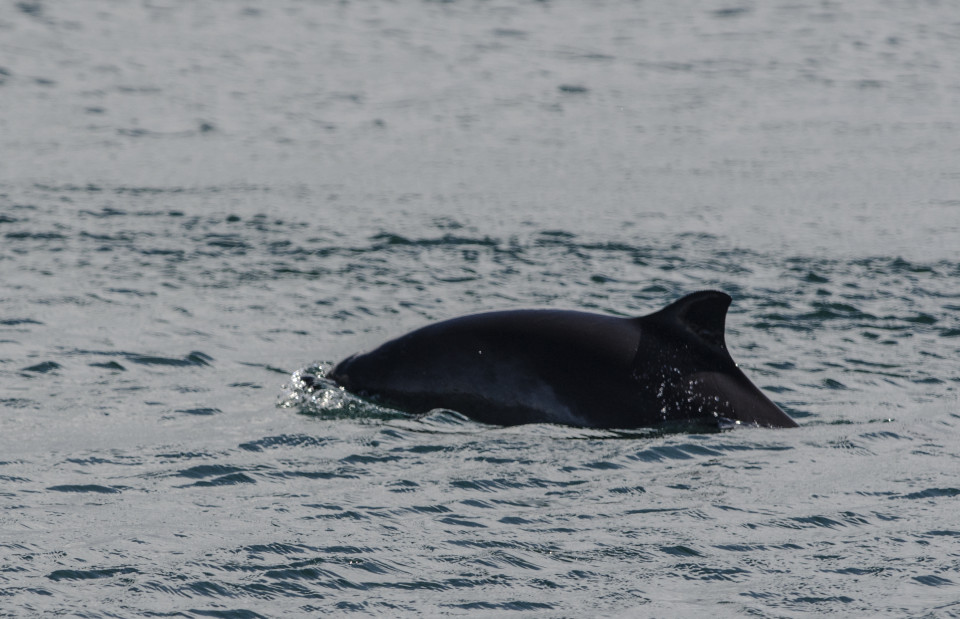
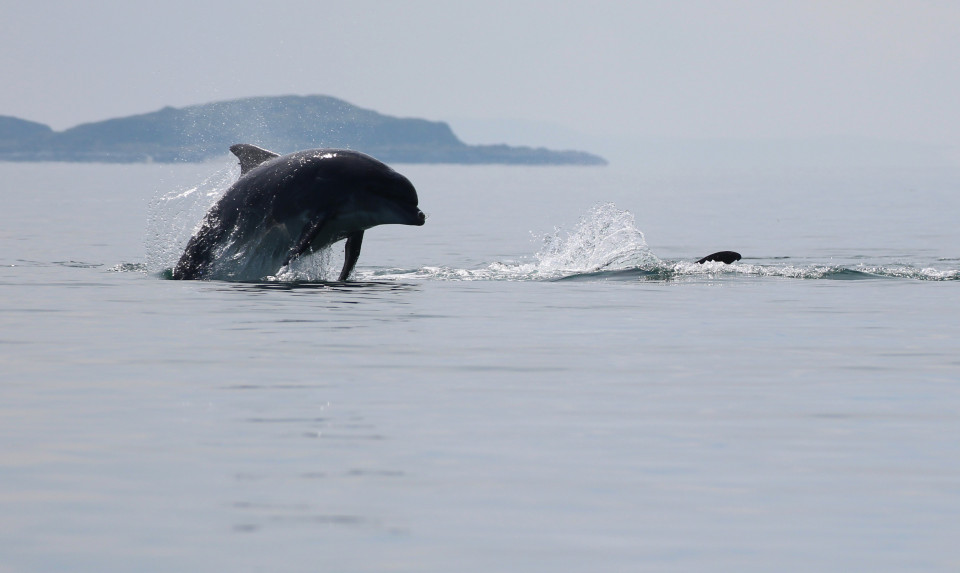
The Bottlenose Dolphin
The bottlenose dolphin is a large dolphin reaching sizes of up to 3.8m and can weigh up to 650kg, with a dark grey dorsal surface, paler underside and short beak they are an instantly recognisable species. They are a surface active species, breaching and spy hopping and performing great aerial acrobatics, they can be very inquisitive and will often come and ride the bow waves next to boats! Usually swimming at speeds of around 6mph they can reach up to 30 mph for short periods of time. Although resident in our waters all year they have an extremely large home range, from the southern tip of Islay all the way up to Skye. Please scroll to the bottom of this page to see some video footage, taken in early 2016 by crew member James Gilpin, of dolphin encounters on our Corryvreckan Wildlife Tours.
Shags and Cormorants
These very closely related seabirds can be quite hard to tell apart, unless side by side as the cormorant is about a third larger than the shag. Shags tend to be a jet black in colour whereas the cormorants are more brown in colour and have a larger creamy patch on their throat and chest. During the breeding season the shags have a pronounced crest which is why they are so named. For seabirds they have relatively little waterproofing oil in their feathers so they get waterlogged wings quite quickly making them less efficient fliers and swimmers so they need to haul out to dry off, they are often seen with their wings out; increasing the surface area for speeding up the drying process.
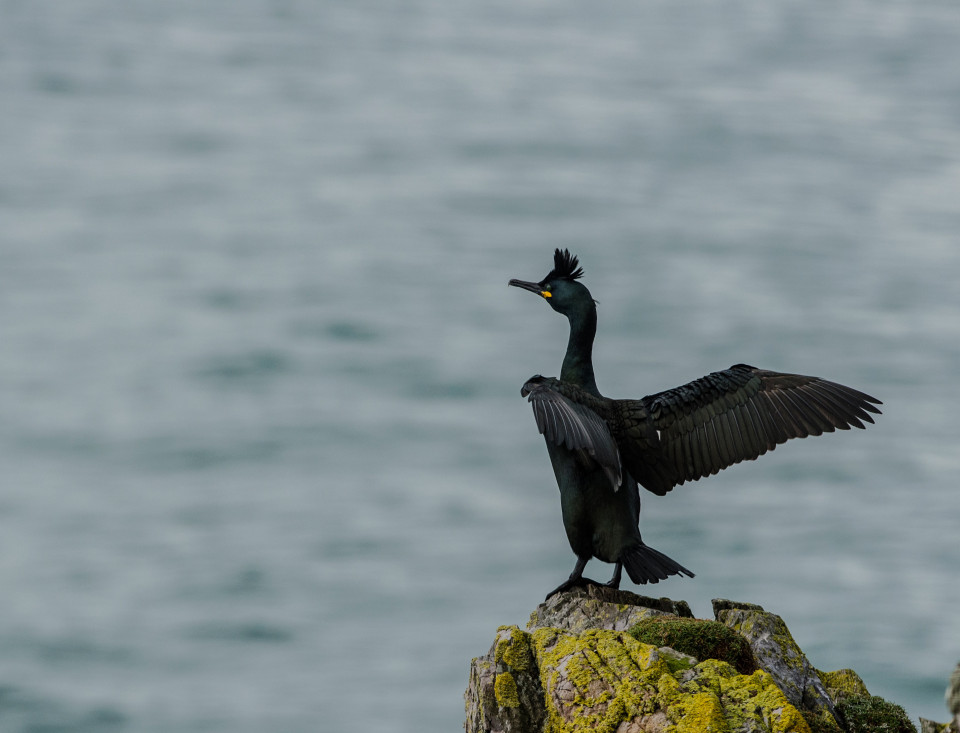
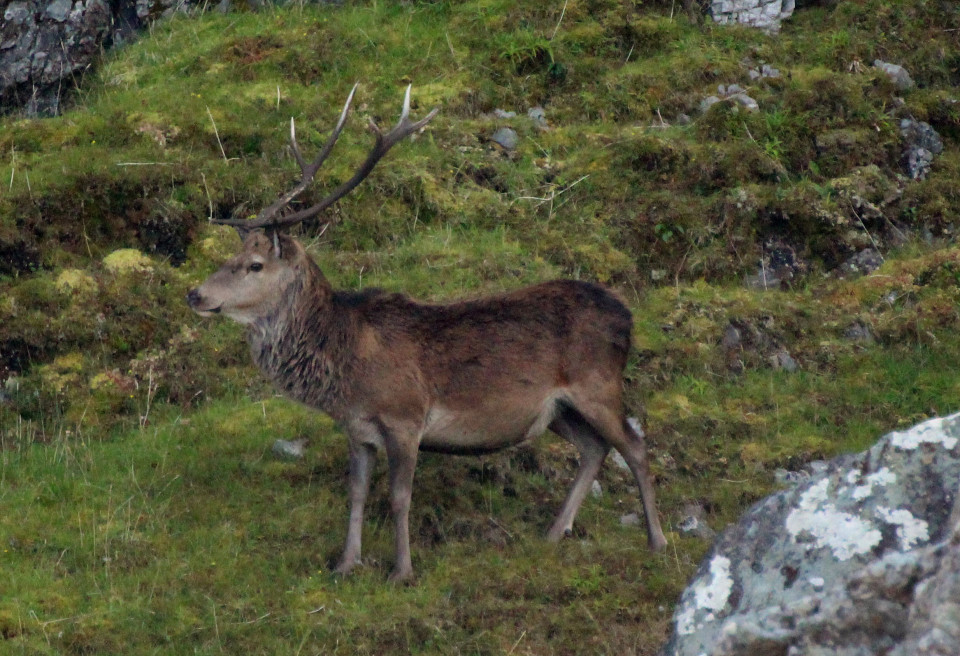
Red Deer
The red deer is the largest land mammal in the UK, a stag can stand at around 137cm at the shoulder and weigh up to 190kg! They breed during the rut in autumn where the males defend a territory and battle it out for breeding rights to a harem of hinds. They fight as a last resort, bellowing and parallel walking to infer dominance and it’s only if the males are fairly evenly matched will they fight, using their antlers as weapons. They cast their antlers each year and grow new ones towards the end of spring, it is the fastest growing mammalian tissue and while growing is covered in a velvet like fur, filled with blood vessels supplying energy and nutrients for growth.
Fallow Deer
The fallow deer are not a native species to the UK and were introduced in the 11th century, the fallow deer on Scarba being introduced as a game species much later. Standing at just under a metre at shoulder height the males, called bucks will weigh about 100kg less than the red deer stags. They have palmate antlers rather than the branched antlers of the red deer and primarily feed on grass.
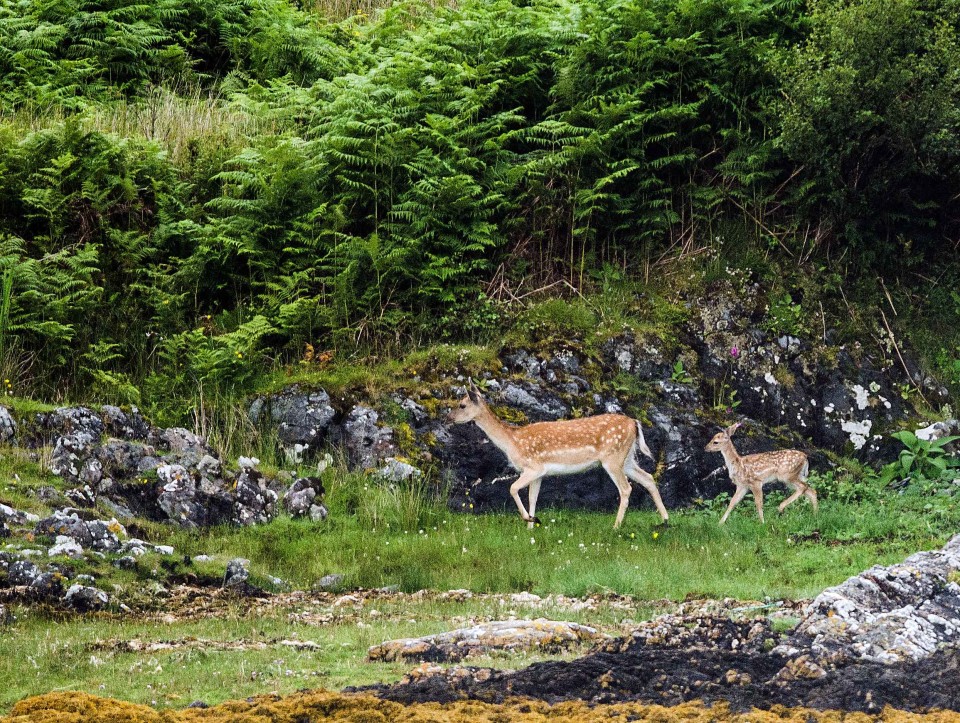
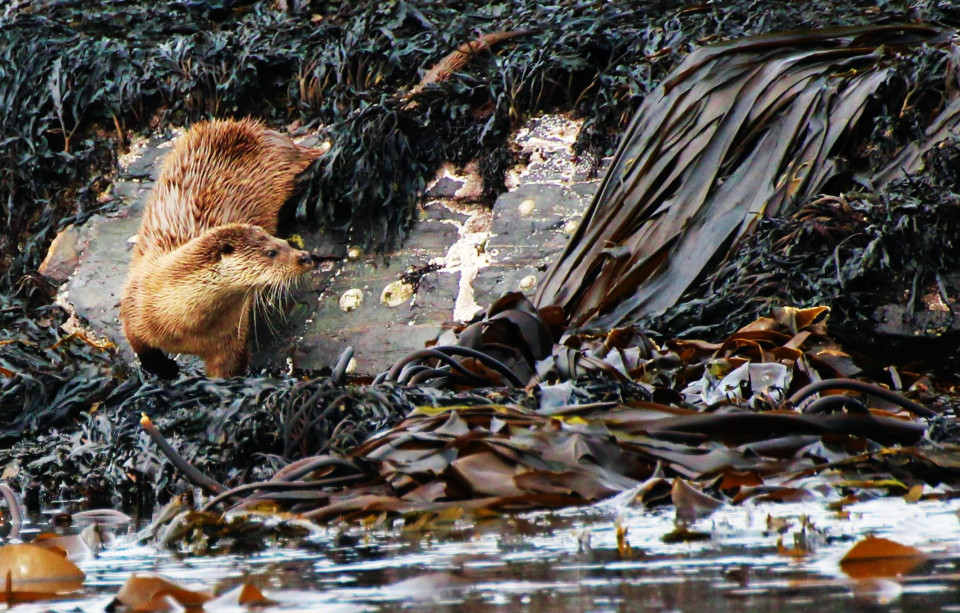
The Otter
The European otter, growing up to 1.1m in length, its tail makes up a third of its total length helping propel them through the water. When they live in fresh water habitats European otters display what is known as crepuscular activity, being most active around dawn and dusk, however when they live in a coastal habitat their activity fluctuates with the tide so we often see them in the middle of the day. Hunting for their favourite quarry of small fish, but they will also eat crustaceans and frogs. Unlike the other marine mammals in the area otters lack a layer of blubber so have 2 layers of fur to provide insulation whilst foraging in the water.
Seasonal Wildlife – Visitors
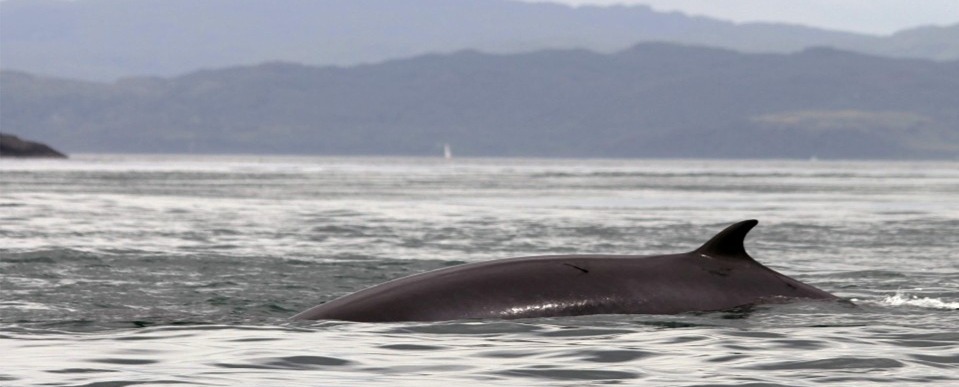
The Minke Whale
Reaching our area towards the end of June each year they spend up to 8 weeks feeding in the food rich water around the Garvellach Islands and Gulf of Corryvreckan.
The minke whale is a baleen whale, a group of whales that, rather than having teeth, have large baleen plates to filter fish like herring and sand eels from the water. The Baleen plates are made up of keratin bristles that trap fish as they expel the large quantities of water they have just taken in. Minke whales are the smallest rorquals, a group within the baleen whales that have large groves on the underside of their throats that allow expansion when taking in gulps of water when feeding. We only see the minke whales in the summer; usually July and August, during the winter they are further south, breeding in warmer waters. They can reach up to 10m in length and weigh in at around 8 tons.
We have dedicated Corryvreckan Wildlife and Whales Tours that tend to start towards the end of June until the beginning of September. Please contact us on 01852 300003 to ask whether we have been seeing whales, we will always give you an honest answer.
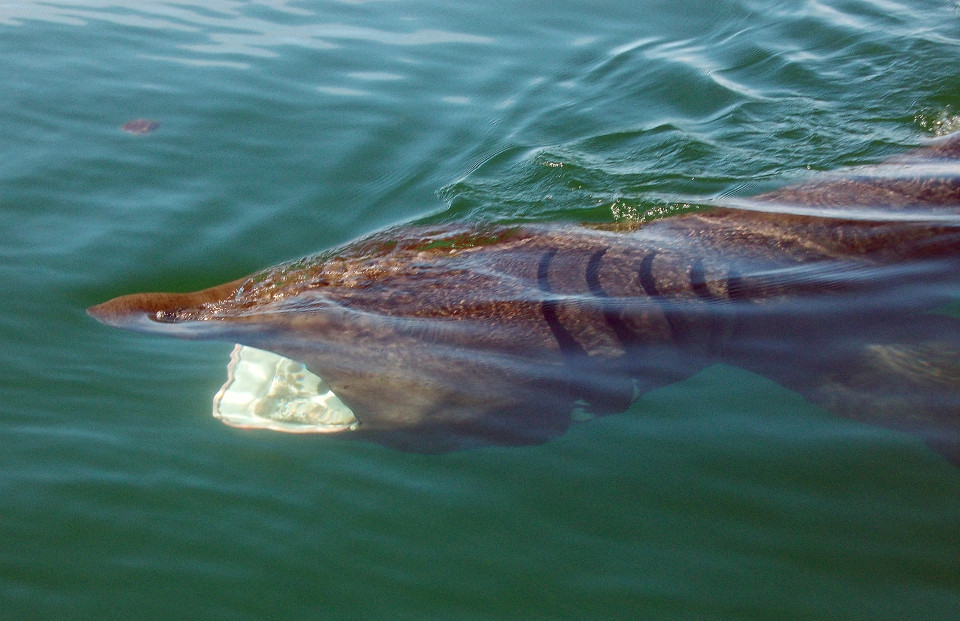
The Basking Shark
Basking sharks also pass through our area during the summer. They are second largest shark in the world and can grow over 10m in length. Similar to the whale shark which is the largest shark in the world the basking shark is also a filter feeder, using gill rakers that catch plankton out of the water it takes in, they can filter up to 1.5 million litres of water per hour! They often feed at the surface where plankton is abundant at certain times of the day and often their nose, tip of their dorsal fin and caudal (tail) fin can be seen above the water.
Seasonal Seabirds
Coming to the coast to breed during the spring and summer we see lots of these seabirds down in the gulf of Corryvreckan which is a great feeding site before they head back out to sea towards the end of August where they spend the majority of the year.
Kittiwakes
The kittiwakes are the UKs most delicate looking gull, as adults they have black wing tips and black legs and feet, as juveniles (like the one pictured) they have a dark patch behind the eye and a black band on the leading edge of their wing.
They have a diet of small fish, primarily sand eels and their breeding success fluctuates in relation to sand eel abundance.
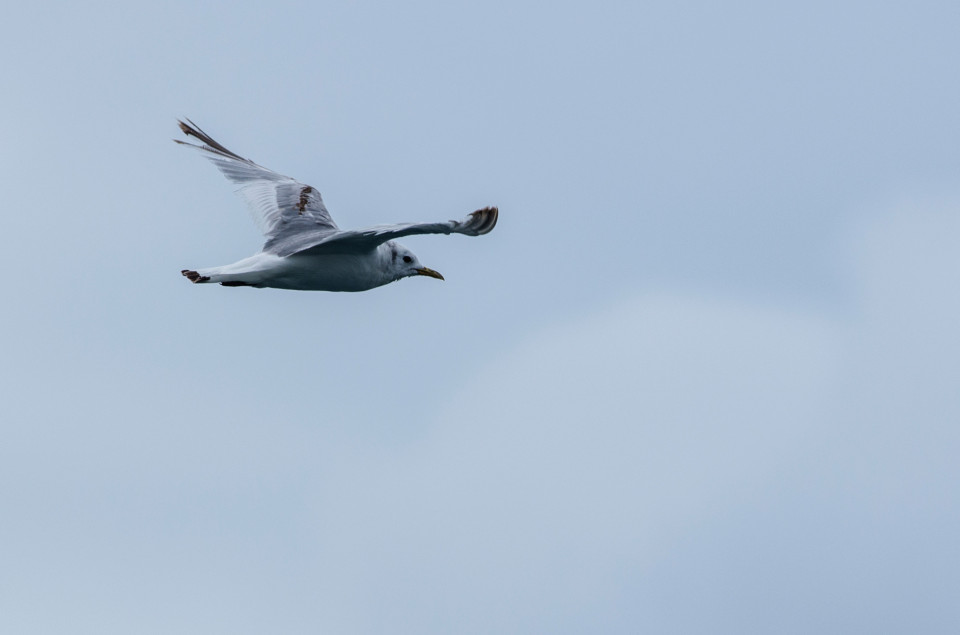
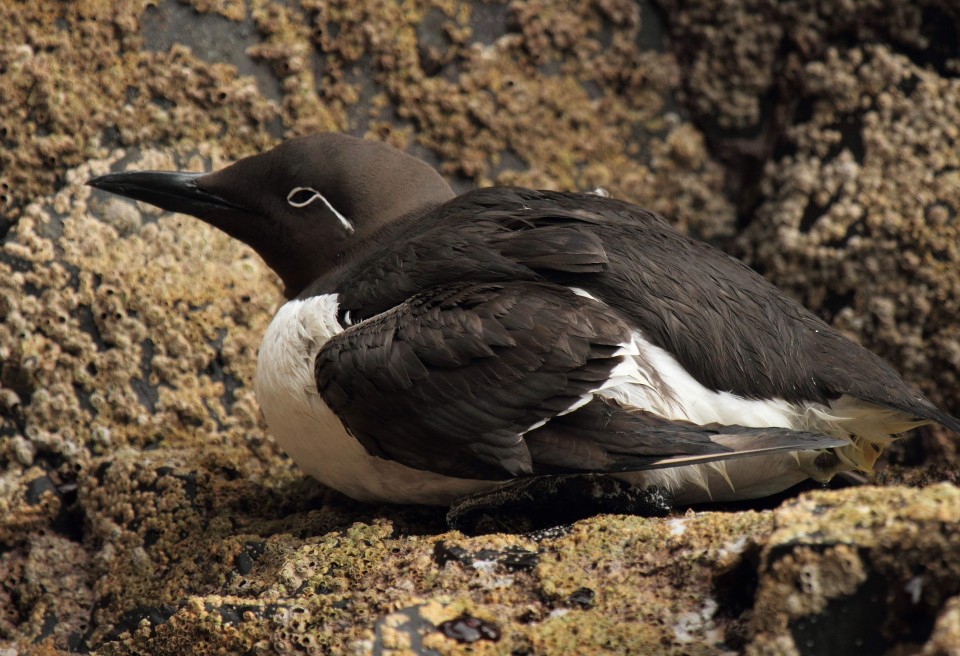
Common Guillemot
The common guillemot is a member of the auk family and relative to the black guillemot that is resident all year. They are slender seabirds, with a white belly and black back, and use their wings to propel them through the water to catch fish. They come to the coast during the spring to nest on ledges on cliff faces, they defend a small nesting territory and will literally be touching their nearest neighbour; to prevent them from falling off the cliff-face their eggs are cone shaped.
Razorbill
The razorbill is another auk, named because its beak has the same shape as an old fashioned cut-throat razor, which also comes to the coast to breed. Although they nest further up on the cliff-faces than the common guillemot so they don’t need the pyriform egg shape.
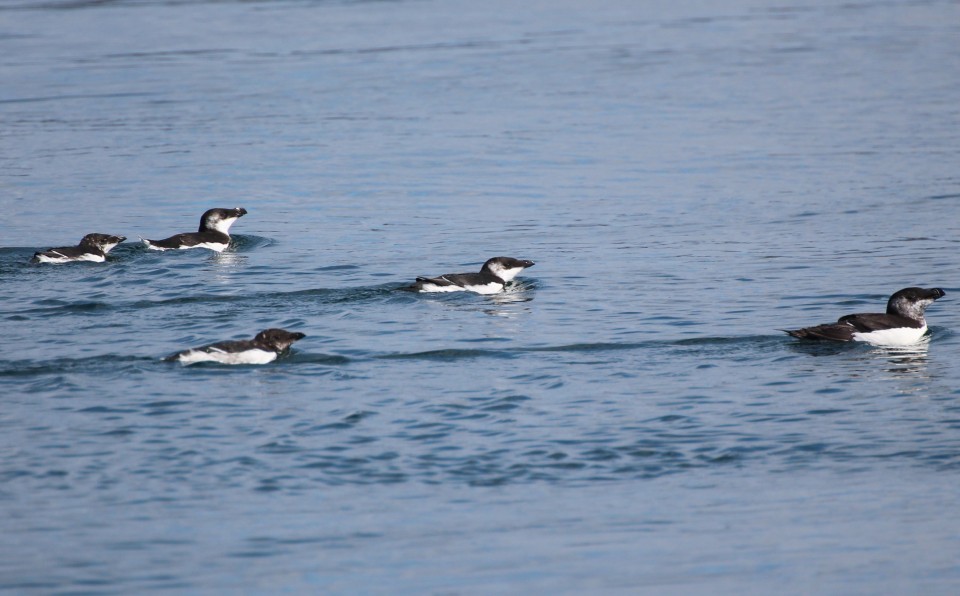
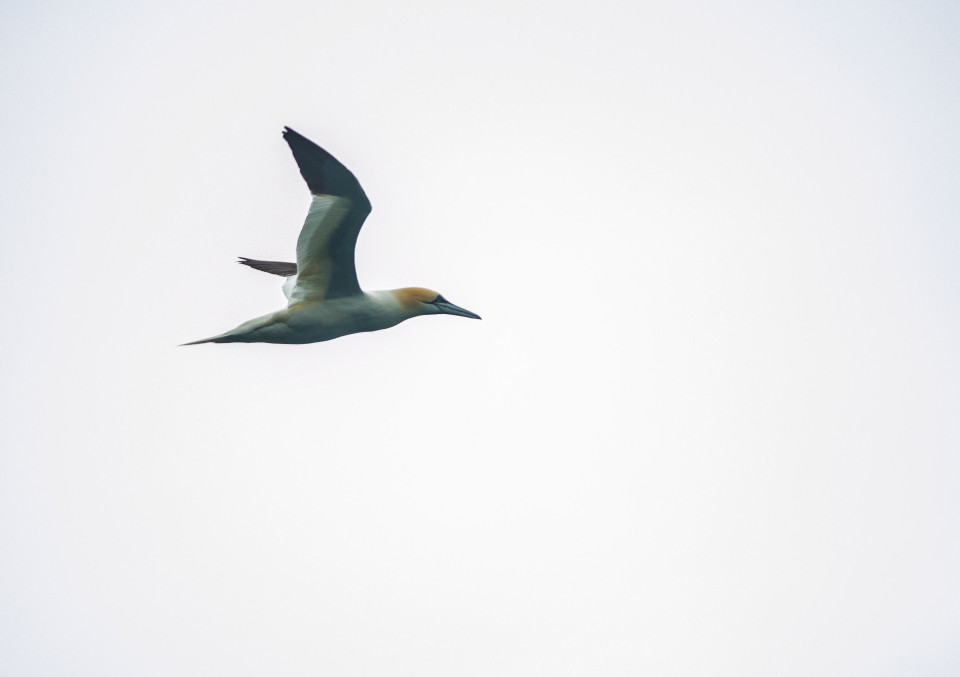
Gannet
The gannet is a large seabird with a wingspan of 1.8m, as an adult they are predominantly white with black wing tips, a creamy face and neck and icy blue eyes. In flight they look pterodactyl like with a bend in the wing at their carpal (wrist) joint. They soar high above the water often at about 30m high looking for fish, on spotting a fish they plummet like arrows at speeds reaching up to 60mph into the water after their prey, they can dive down to 20m depth after a fish and stay underwater for 30 seconds. They often feed in association with cetaceans as they bring shoals of fish close to the surface of the water. The gannets we see in our area breed down on Ailsa Craig in the firth of Clyde and travel up to feed in the rich waters in the gulf of the Corryvreckan.
